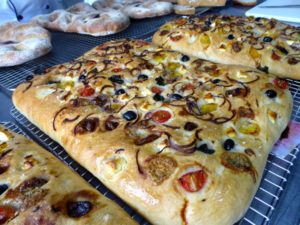
BREAD is one of the oldest prepared foods and is usually made from dough of wheat-flour and water that is cultured with yeast, allowed to rise and finally baked. It is the staple food of the Middle East, North Americas, Europe and European-derived cultures such as the Americas, Australia and Southern Africa.
In contrast, rice is the staple in East Asia. But the “panaderia” or local bakery in the Philippines has become a familiar sighting in many neighborhoods.
The “panaderia” started out as the Royal Bakeshop of the Spanish government in Intramuros in the 17th century, according to food historian Felice Sta. Maria.
The Royal Bakeshop catered to Spaniards who longed for bread from their homeland. The ubiquitous Pan de Sal (Spanish for “bread of salt”) was introduced and became the Filipino breakfast staple.
The International Culinary Arts Academy of Cebu (ICAAC) is currently offering Recreational Cooking and Baking courses until May 2018.
Dean/Chef Jeremy Young and his Pastry Chef-wife Fatima invited this writer to a one-day Basic Bread Class. Frankly, I prefer baking cakes and pastries.
Baking bread can be time-consuming and needs a lot of patience. I have attended several demonstrations on bread making.
This time, I decided to “feel” the art of making bread. I drove all the way to their culinary school in Guadalupe one Saturday morning.
There, I met my three other classmates over continental breakfast before we started at 10 in the morning.
To save on time, all the ingredients have been weighed and prepared.
The bread recipes for the day’s lesson included Plain White Loaf, Fougasse, Focaccia and Turkish Style Bread. Our focus was to learn the simple basic techniques.
Chef Jeremy gave a short lecture before he started the demonstration including a few pointers like fat makes bread softer, slower fermentation gives better flavor, kneading by hand the artisanal way gives the bread the desired texture and holes.
The basic bread ingredients include bread flour, salt, instant dried yeast, olive oil and cold water.
After closely observing Chef Jeremy who had so much skill and grace in mixing and kneading the dough, I mustered enough determination to do at least half as good as he did.
Using only one hand (I am right-handed), I combined the ingredients together until a dough mass was formed, tipped over the dough out onto a lightly floured surface and kneaded for 10 to 15 minutes, taking a rest period of 1 minute every 2 minutes of kneading, until the dough is smooth and elastic.
And here is the fun part of kneading—with left hand taking the dough in front and the right hand lifting the dough from behind, I slapped the ball of dough hard on the table, stretching the sides and folding it over, repeating the procedure a few times before giving the dough a short rest. Cutting a small portion, I tested for the elasticity stretching it like a balloon.
Chef Jeremy explained that yeast breads need flour with higher levels of gluten (12 percent protein) for this elasticity. In a lightly oiled bowl, large enough to allow the dough to double in bulk, I placed the dough in the bowl, covered with plastic wrap in warm (25 to 27 degrees C) for one hour to poof.
I gently knock back the dough by gently folding it back onto itself, deflating it lightly, cover once again and poof for another 30 minutes. Presto, the dough is ready to be formed into the pans for baking in preheated oven 250 degrees C.
Use steam in the oven to prevent drying and crusting of the outer skin.

